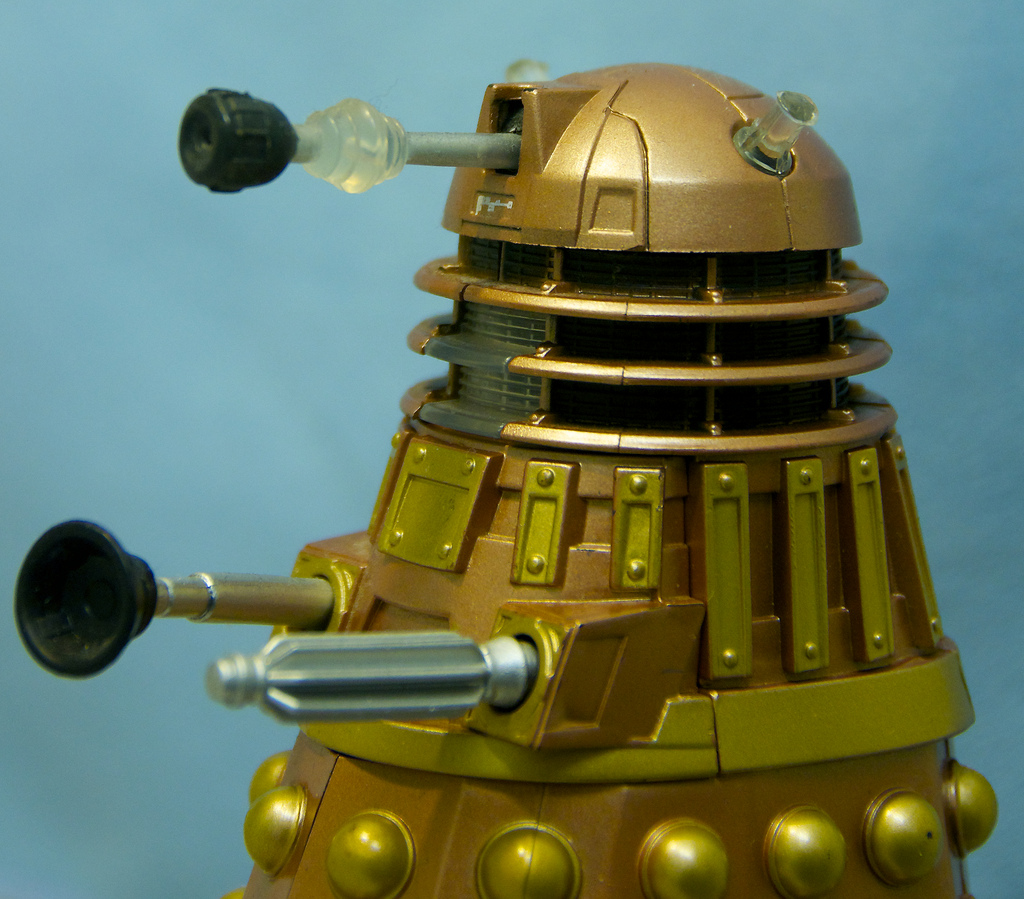
June 9, 2016, by Brigitte Nerlich
Antibiotic resistance, citizen science and Daleks
This morning I was having my first cup of coffee while listening to the Radio 4 Today programme. At 6.55 an item came on that made me laugh – and guess what: it was about antibiotic resistant bacteria! For a while now I have been worried that in order to raise public awareness about the dangers posed by the rise of drug resistant infections, communicators have opted for metaphors that instil fear, such as the ‘post-antibiotic apocalypse’. Such metaphors may very well scare people, but I doubt they make people care about this important issue. After listening to this snipped on the radio I thought: Here is a way to make people care: Daleks! Why didn’t I think of that! But let’s backtrack a bit and see how it all began.
Dalek to the rescue
For an episode of Inside Science, Adam Rutherford collaborated with another Adam, Adam Roberts, a specialist in microbial diseases and antibiotic resistance at UCL. Adam Roberts is engaged in a project called ‘Swab and Send’, a citizen science project on antibiotic resistance. For the Inside Science episode today (9th of June) Adam Rutherford swabbed quite a few things within the BBC’s Broadcasting House, such as microphones, a sponge, door mats and so on to see whether he could find some bacteria that killed other bacteria, that is bacteria that had antibiotic potential. Very early this morning he went to Broadcasting House to talk with Sarah Montague and Nick Robinson on the Radio 4 Today programme about what he found.
As I said, Adam swabbed lots of objects in Broadcasting House, including, just for the fun of it, the sink plunger on a gold Dalek that stands in the foyer. He sent the swabs to Adam Roberts’ lab where they were analysed to find out whether any of the bacteria found had developed an antibiotic resistant strain.
Finding new antibiotic producing bacteria is a real challenge and scientists are scouring heaven and earth to find them. In this case they scoured the BBC and found some indication that, wait for it, the Dalek’s sink plunger might harbour a novel molecule of antibiotic interest. In fact three bacterial colonies on the Dalek produced bacteria that killed the Micrococcus indicator strains used to test them. They exhibited the power to, I quote Adam Roberts, “exterminate” other troublesome bacteria! Listen to this (54 minutes into the Today programme) and this clip from Inside Science here.
Swab and Send – a citizen science project
All this aroused my interest in the Swab and Send project which I hadn’t heard about but which is actually a year old. The project is led by Adam Roberts and his PhD student Tim Walker. This is a crowd-sourced citizen science project. As the project description says: “Most of the antibiotics we currently rely on are naturally produced by bacteria and fungi from various competitive environments such as soil. These microbes produce lots of different antibiotics to kill their competitors so they can have all the food and space. This gives us an opportunity. If we can find new antibiotics that microbes are producing we can use them to kill bacteria that cause infections in humans and animals.”
In order to find new antibiotics they ask people to send them swabs, but not any old swabs. Citizens are asked to “choose a potentially competitive environment to swab. Swabs could be taken from anywhere you find interesting; from drains, sinks, floors, houseplants, compost heaps, the bottom of your shoe, the back of your fridge or puddles (sorry but no human or animal samples allowed). Anywhere that you think different bacteria will be competing for space and food is suitable. We want you to swab the weird and wonderful places your imagination can come up with.”
As far as I can see people have sent in swabs from likely places, such as dirty tea towels and phones, to the most unlikely places, such as an unused barn owl box. When analysing all these samples, the scientists even found a bacterial colony resembling a vomiting teddybear that inhibited Micrococcus.
For more information about the project you can read this blog post and this article. Fascinating stuff!
Conclusion
So, from Daleks to Teddybears – at last we are now finding fear-resistant ways of talking about antibiotic resistance!
As Adam said on Inside Science “Antibiotic Resistance is futile” (added in the afternoon)
And now you can see the ‘extermination zones’!! Swab and Send post by Adam Roberts (added 10 June)
PS: Just after I posted this, an article summarising the whole episode was posted in the Radio Times!
Image: Flickr (labelled for reuse on Google images)

I’m not sure swabbing all and sundry will raise the awareness of antibiotic resistance. I think most will likely interpret this as: problem solved, a new way of finding new antibiotics and business as usual.
I have to say that I see it as more of a desperate measure. We are going to need some new thinking about this situation.
Yes, a few Daleks won’t make a summer so to speak! Let’s hope the ESRC’s call for social science proposals on AMR will provoke some new thinking… we’ll have to wait and see…